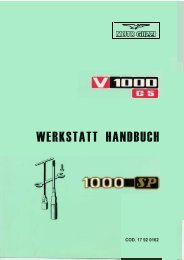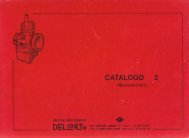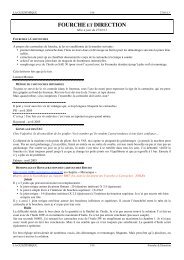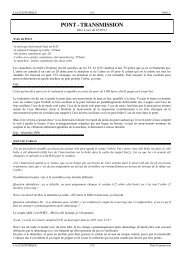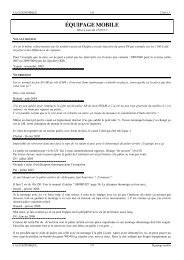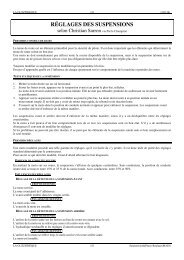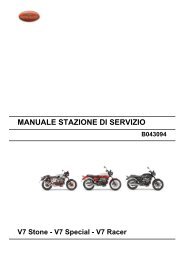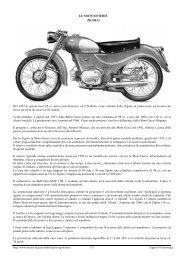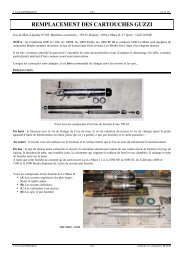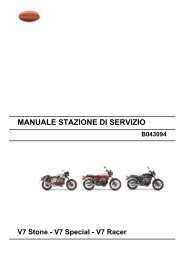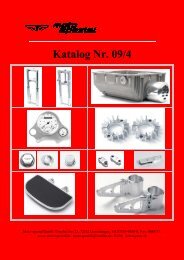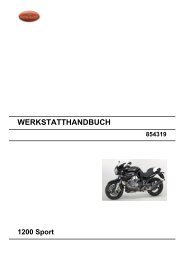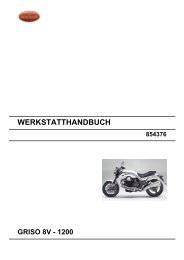Carburateurs Dell'Orto - Guide technique
Carburateurs Dell'Orto - Guide technique
Carburateurs Dell'Orto - Guide technique
You also want an ePaper? Increase the reach of your titles
YUMPU automatically turns print PDFs into web optimized ePapers that Google loves.
LA GUZZITHÈQUE 21/21 19/03/04<br />
• Connect each barrel to the mercury manometer, taking off the blanking plugs provided on the vacuum intakes and fitting<br />
instead the proper vacuum connectors. If a compensator is fitted, dismantle it and connect the compensator connections to<br />
the mercury manometer.<br />
• Unscrew each idle mixture screw (3) about two turns from the fully-closed position.<br />
• Start the engine and when it has reached normal running temperature, adjust the idle speed to about 1000 rpm using the<br />
throttle adjusting screw (2) in figure 31 or screw (4) in figure 32.<br />
• Or independent carburettors (figure 31) align the mercury column levels using the throttle adjusting screws (2) on each<br />
carburettor.<br />
• For carburettors mounted together in a group (figure 32) align the mercury column levels with the level of the carburettor<br />
connected directly to the throttle control, adjusting the balance- adjusting screws (5), (6), (7).<br />
• Then adjust the mixture screws (3) of each carburettor to obtain the fastest even running.<br />
• Recheck the alignment of the mercury columns and then reset the engine to the desired idle speed using the throttle<br />
adjusting screw (2) in figure 31 or screw (4) in figure 32.<br />
• For independent carburettors (figure 31) check that the alignment of the mercury columns is unaffected by slightly opening<br />
the throttle. If it is, adjust the individual cable-adjuster screws (1) to correct this.<br />
• Finally, disconnect the manometer unions and refit the blanking plugs or the compensator piping.<br />
Where the carburettor group has been dismantled for servicing, some approximate synchronisation will be helpful before<br />
reassembling; see that all the slides are opened 1mm and that the idle mixture screws are opened two turns from the fullyclosed<br />
positions.<br />
The throttle valve opening securing-screw (A) should be adjusted is such a way that it allows full opening of the throttle slides<br />
up to a maximum of 1mm beyond complete clearance of each carburettor barrel.<br />
5. FACTORS WHICH CAN AFFECT CARBURATION<br />
In some cases, carburation which has been properly set up in particular conditions can then be upset by certain factors ie.<br />
• a change of fuel used<br />
• a change in atmospheric pressure<br />
• a change in air temperature<br />
5.1 CHANGE OF FUEL<br />
When a different fuel other than commercial petrol is used, it is necessary to estimate theoretically the new stoiciometric<br />
mixture ratio and consequently change all the jet sizes to suit.<br />
If the stoiciometric mixture ratio decreases, larger jets are required and vice versa. Any such changes should,.of course, be<br />
made on a percentage basis ie. when the stoiciometric ratio in creases by a certain percentage, the jet sizes should be reduced<br />
by that percentage.<br />
For example, if commercial petrol (stoiciometric ratio 14.5) is replaced by methyl alcohol (methanol, with chemical formula<br />
CH3OH - stoiciometric ratio 6.5) the jet sizes should be increased by about 50 % ie. double the flow rate. If fuel consisting of<br />
25% petrol and 75% methanol is used, jet sizes should all be increased by 30 % with fuel composed of 50 % petrol and 50 %<br />
methanol, the jet sizes need only be increased by 18% compared to when using straight petrol.<br />
You should also replace the needlevalves, increasing the seat sizes accordingly.<br />
When using special fuels such as methanol, it is very important that all the component materials of the carburettors have been<br />
treated, wherever necessary, to resist chemical attack. For example, nylon components should be removed, and replaced by<br />
other parts resistant to the new fuel.<br />
5.2 CHANGES IN ATMOSPHERIC PRESSURE AND IN AIR TEMPERATURE<br />
Variations in pressure or temperature cause a change in the air density and consequently a change in the fuel-air ratio and<br />
further tuning may therefore become necessary.<br />
A decrease in atmospheric pressure with consequent decrease in air density causes a mixture enrichment and smaller jets will<br />
therefore be required.<br />
Altitude variations also produce changes in the carburation and they too cause changes in the air density; prolonged use of a<br />
vehicle at an altitude higher than 1500 metres, the carburation of which was originally set up for operation at around sea level,<br />
would require a change of jet sizes in proportion to the pressure change.<br />
In this case too, a decrease in pressure should be compensated by a reduction of the jet sizes. Furthermore, a lowering of air<br />
temperature produces an increase in air density and consequently a mixture weakening; therefore an increase in the jet sizes is<br />
required.<br />
Summarising, we can say that any decrease in air pressure, any increase in altitude or in air temperature should be<br />
compensated for by a decrease in the jet sizes.<br />
Conversely, any increase in pressure or any decrease in altitude or in temperature should be compensated by an increase in the<br />
jet sizes.<br />
LA GUZZITHÈQUE 21/21 Dellorto Tuning <strong>Guide</strong>



